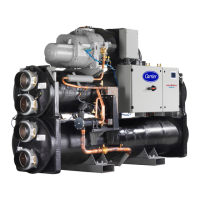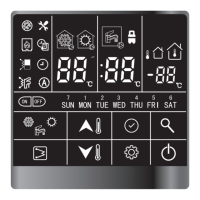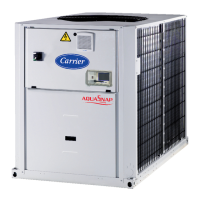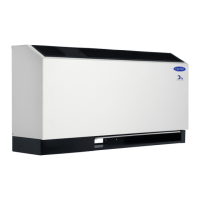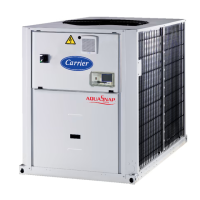Do you have a question about the Carrier AquaForce 30XW-V and is the answer not in the manual?
Safety precautions for unit installation, including handling, site preparation, and personal protective equipment.
Classification of safety devices for protection against overpressure and fire damage.
Information on equipment and components designed to operate under pressure, including compliance and documentation.
Safety precautions for maintenance, including PPE, qualified personnel, and logbook requirements.
Safety guidelines for repairs, including PPE, purging procedures, and handling of refrigerants and components.
Warning about using air or oxygen for leak tests, which can cause explosions with oil and grease.
Procedure for inspecting the unit upon receipt for damage, missing parts, and confirming order accuracy.
Guidelines and precautions for moving and positioning the unit at the installation site.
Pre-start-up verification checklist for the refrigeration system, installation, and components against diagrams.
Physical dimensions and required clearances for 30XW-V/30XWHV units, models 580 through 880.
Physical dimensions and required clearances for 30XW-V/30XWHV units, models 1150 through 1710.
Technical specifications including sound levels, dimensions, weight, compressors, oil, refrigerant, and capacity control.
Detailed electrical specifications including power supply, start-up current, power factor, harmonic distortion, and power input.
Information on the short-circuit stability current and main disconnect switch for all units.
Nominal voltage, frequency, and current ratings for different compressor models.
Table showing compressor models and their compatibility with specific unit ranges.
Guidelines for power supply requirements, voltage range, and phase imbalance.
Explanation and example for calculating and checking voltage phase imbalance for safe operation.
Details on the number of connection points for power connection/disconnect switches based on unit model and options.
Guideline for selecting appropriate wire sections for electrical connections based on current and installation methods.
Information on how power cables enter the control box, including location and access.
Instructions for field control wiring, precautions, and available standard/optional features.
Details on the available 24 V AC and 230 V AC power reserves for user control wiring.
Specifies the minimum and maximum operating limits for the evaporator and condenser.
Recommendations for condenser-side installation, especially for low condenser water temperatures.
Details on minimum chilled water flow requirements and recirculation options.
Information on maximum chilled water flow limits and bypass options.
Details on minimum and maximum condenser water flow rates and options for higher flow.
Table showing the number of passes for evaporator and condenser based on unit model and options.
Table providing minimum and maximum water flow rates for evaporator and condenser.
Graphical representation of minimum temperature differences for condenser and evaporator operation.
Guidelines for using variable evaporator flow, including control and system volume requirements.
Formula and guidance for calculating the minimum water loop volume for stable operation.
Graphs showing pressure drop curves for evaporator and condenser based on water flow rate.
Precautions for water circuit design and connection, including pipework, air purging, and fluid compatibility.
Recommendations for heat exchange fluids, detailing acceptable ion content and pH levels.
Details on Victaulic type water connections, including inlet/outlet diameters for evaporator and condenser.
Information on evaporator flow switch and chilled water pump interlock, and adjustment procedures.
Procedure and sequence for tightening water box bolts on the evaporator and condenser.
Configuration and operation of two units in master/slave mode, including control and pump management.
Physical data for 30XWHV heat pumps, referencing chapter 4.1 for details.
Electrical data for 30XWHV heat pumps, referencing chapter 4.2 for details.
Dimensions and clearances for 30XWHV heat pumps, referencing chapter 3 for details.
Operating limits for 30XWHV heat pumps, referencing chapter 6.1 for details.
Description of cooling and heating operating modes for 30XWHV heat pumps.
Details on 06T geared twin-screw compressors, their control modes, and models used.
Information on the independent oil filter for the 06T screw compressor.
Specifies that 30XW-V/30XWHV units only use refrigerant R-134a.
Approved lubricants for the 06T screw compressor, including Carrier specifications.
Description of the oil supply solenoid valve used to isolate the compressor from oil flow.
Information on pressure vessels, including general monitoring, repair, recycling, and operating life.
Description of the SRMCR high-pressure safety circuit, its operation, and testing requirements.
Option for chilled brine solution production down to -3°C using ethylene glycol.
Option for two units in parallel for optimised operation and time equalisation.
Option for unit power connection via a single main supply connection.
Option for electrical power and control for one or two evaporator pumps.
Option for electrical power and control for one or two condenser pumps.
Thermal insulation for the condenser to reduce thermal dispersions and aid compliance.
Includes liquid line and suction line valves for simplified service and maintenance.
Option for evaporator with one pass on the water-side, reducing pressure drops.
Option for condenser with one pass on the water-side, reducing pressure drops.
Reinforced evaporator for higher water-side service pressure (21 bar).
Reinforced condenser for higher water-side service pressure (21 bar).
Evaporator with reversed water inlet/outlet for specific site requirements.
Condenser with reversed water inlet/outlet for specific site requirements.
Two-directional communication board complying with Lon Talk protocol.
High-speed communication via BACnet protocol over Ethernet network.
Bi-directional communication using Modbus protocol over Ethernet network.
Limits maximum condenser leaving water temperature to 45°C for downsizing components.
Output signal to control condenser water inlet valve for low temperature systems.
Control board with additional inputs/outputs for extended remote control.
0-10 V signal to report refrigerant leakage, requiring customer-supplied detector.
Three-way valve upstream of dual relief valves for facilitated replacement and inspection.
Additional tests and PED documents for compliance with Swiss regulations.
EAC certification for compliance with Russian regulations.
Unit approval to Australian code for compliance with Australian regulations.
Evaporator piping sound insulation providing 3 dB(A) quieter operation than standard.
Victaulic piping connections with welded joints for easy installation.
Victaulic piping connections with welded joints for easy installation.
Victaulic piping connections with flanged joints for easy installation.
Victaulic piping connections with flanged joints for easy installation.
Compressor covered with thermal insulation to prevent condensation.
Additional RFI filters on the unit power line for reduced electromagnetic interferences.
Label with rated power, current, EER for compliance with UAE standard.
Specific documents according to Morocco regulation.
Simple preventive maintenance tasks for users, including visual checks and filter inspection.
Maintenance requiring specific skills, including connection tightening and component checks.
Advanced maintenance requiring manufacturer expertise, like component replacement or refrigerant handling.
Torque specifications for tightening main electrical connections, including customer and variator connections.
Torque specifications for tightening various bolts and screws on the unit, including chassis and compressor fixings.
Checks for evaporator and condenser maintenance, including insulation, sensors, and water connections.
Details on compressor maintenance, including oil filter changes and rotation control.
Maintenance procedures for the frequency variator, including safety precautions and fan replacement.
Description of optional service valves for facilitating maintenance and repair operations.
Procedure for periodic testing of the high pressure safety loop and verification of trigger values.
Procedure for shutting down the units, including separation from energy sources and cooling.
Guidelines for disassembling the unit, sorting components for recycling, and checking for reusable parts.
List of fluids like refrigerant, heat-transfer fluid, and compressor oil to be recovered for treatment.
List of materials such as steel, copper, aluminium, and plastics for recycling.
Procedure for disassembling and processing WEEE, including removal of contaminated fluids.
Section for recording preliminary job, location, contractor, distributor, unit model, and component details.
Checklist for verifying shipping damage, unit installation, wiring, connections, and water venting.
Checklist for unit start-up, including oil level, valve status, leak checks, and voltage imbalance.
Checklist for cooler water loop, including volume, corrosion inhibitor, freeze protection, and piping.
Procedure for checking pressure drop across the cooler and comparing with performance data.
